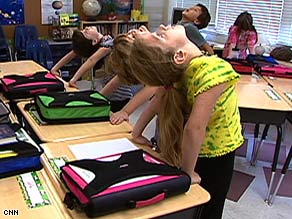 When I taught grades K-8 in a one-room schoolhouse, we began each morning with the sun salutation, only I called it the “good morning” stretch in order to not freak out some right wing parents.
When I taught grades K-8 in a one-room schoolhouse, we began each morning with the sun salutation, only I called it the “good morning” stretch in order to not freak out some right wing parents.
We would go to the grassy field, form a circle, and flow through this vinyasa each morning. On rainy days, we modified this practice in the classroom. I’ve recently come across several articles about yoga in the classroom and the benefits to children.
Library’s Combined Reading, Yoga Program for Children Stretches Bodies, Minds: A program in south Florida combines literacy with yoga. Children in grades preK through second grade learn different yoga poses as they read Eric Carle’s classic The Very Hungry Caterpillar. Linda Citron, a yoga instructor that runs the program and holds a master’s degree in dance movement therapy, believes:
The program introduces children to yoga in an exciting, fun-filled way. It is a unique approach to integrate learning using yoga as a pathway. Reading, storytelling, music, creative arts blend seamlessly with yoga movements to educate the whole child. It enhances motor coordination, works on cognitive development, works on focus, concentration, relaxation, develops flexibility and strength in the body.
In a related story, last summer a South Carolina library program shut down after being accused of promoting “witchcraft” and “drug use.” Some parents objected to the yoga programs as “promoting other religions.”
Kids Use Yoga to Learn Mythology, Fight Pre-test Jitters: In Georgia, teachers are using yoga to help children concentrate, as well as learn the symbols of Greek Gods. According to school counselor June Neal, “We’ve seen an improvement in test scores and test-taking skills because their stress level is decreased after yoga.” The teachers received training from Yoga Kids International. Now that’s an inservice day I would enjoy!
Teaching to the Mind, Body and Spirit of Our Students: This informative article was written by Christine McArdle-Oquendo, co-founder of World Family Yoga. As Christine explains,
As teachers we know that a student who is physically, emotionally, mentally and spiritually healthy is a student who is in optimum learning and growing form, while those who are more challenged in any of these areas aren’t often our highest-performing students. By introducing simple yogic practices into your classes, including simple breathing techniques, stretches or physical postures, visualizations and/or meditations, you will touch your students in a profound way. You will potentially touch a child’s core and ignite their inner fire.
Although I have never used yoga to teach other subject areas, as I believe the benefits of yoga warrant yoga for yoga’s sake, I see there are a lot of connections yoga can help children make physically and cognitively in the classroom. As a preK teacher, I will look for new opportunities to use asanas in the classroom and perhaps volunteer in my daughter’s classroom to add yoga to her curriculm.
Image source: CNN
My husband does “stretch breaks” with his third-grade class. He too, avoids calling it yoga in his VERY conservative, farming community.
He usually has them draw three to five cards from a yoga deck. He reports that it perks them up when they’re groggy and settles them down when they are rambunctions, but really need to sit and focus. He also reports that they get great enjoyment from watching him attempt some of the poses!